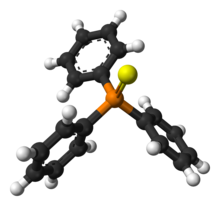Triphenylphosphine sulfide

| |

| |
| Names | |
|---|---|
| Preferred IUPAC name
Triphenyl-λ5-phosphanethione | |
Other names
| |
| Identifiers | |
3D model (JSmol)
|
|
| ChemSpider | |
| ECHA InfoCard | 100.021.280 |
PubChem CID
|
|
| UNII | |
CompTox Dashboard (EPA)
|
|
| |
| |
| Properties | |
| (C6H5)3PS | |
| Molar mass | 294.350461 g/mol |
| Appearance | Colourless solid |
| Melting point | 161 to 163 °C (322 to 325 °F; 434 to 436 K) |
| Solubility | soluble in dichloromethane, ethanol |
| Related compounds | |
Related compounds
|
Triphenylphosphine oxide |
Except where otherwise noted, data are given for materials in their standard state (at 25 °C [77 °F], 100 kPa).
| |
Triphenylphosphine sulfide (IUPAC name: triphenyl-λ5-phosphanethione) is the organophosphorus compound with the formula (C6H5)3PS, usually written Ph3PS (where Ph = phenyl). It is a colourless solid, which is soluble in a variety of organic solvents.
Structurally, the molecule resembles the corresponding oxide, with idealized C3 point group symmetry.[1] It is weakly nucleophilic at the sulfur atom.
Applications
[edit]Organic synthesis
[edit]Triphenylphosphine sulfide is useful for the conversion of epoxides to the corresponding episulfides:[2]
- Ph2C2H2O + Ph3PS → Ph2C2H2S + Ph3PO
It also reacts with ketenes to form thioketenes:[3]
- Ph2CCO + Ph3PS → Ph2CCS + Ph3PO
Analytical chemistry
[edit]In analytical chemistry, triphenylphosphine is used for the analysis of certain kinds of sulfur compounds. Elemental sulfur (S8), as occurs in some oils, and labile organosulfur compounds, such as organic trisulfides, react with triphenylphosphine to give Ph3PS, which can be detected by gas chromatography.
References
[edit]- ^ Codding, P. W.; Kerr, K. A. (1978). "Triphenylphosphine sulfide". Acta Crystallographica Section B. 34 (12): 3785. Bibcode:1978AcCrB..34.3785C. doi:10.1107/S0567740878012212.
- ^ Mayhew, Darrin L.; Clive, Derrick L. J. (Apr 15, 2001). "Triphenylphosphine Sulfide". Encyclopedia of Reagents for Organic Synthesis. New York, NY: John Wiley. doi:10.1002/047084289X.rt379. ISBN 0-471-93623-5.
- ^ Staudinger, H.; Meyer, Jules (1919). "Über neue organische Phosphorverbindungen III. Phosphinmethylenderivate und Phosphinimine". Helvetica Chimica Acta. 2 (1): 635–646. doi:10.1002/hlca.19190020164. ISSN 0018-019X.
